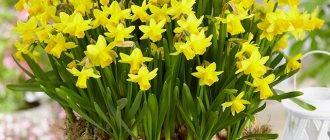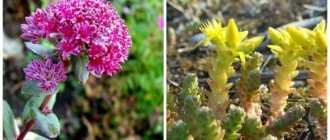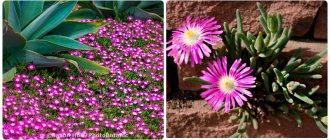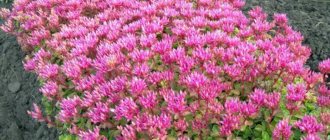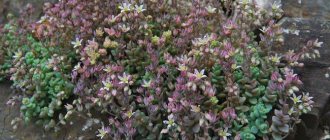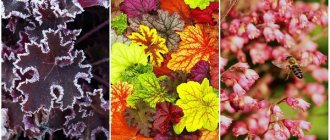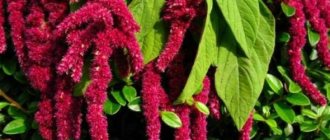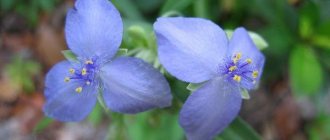Sedum is a decorative succulent that is widely in demand in the design of city flower beds, park areas and private gardens. In terms of ease of care and planting, this plant has few equals in ornamental gardening. Popularly, sedum grass is also called fever herb or hernia grass due to its healing properties, well known to herbal healers. There is a myth according to which the son of Hercules Telephos coped with a severe wound inflicted on him by the spear of Achilles, precisely with the help of sedum grass. The appearance of these flowers is simple and artless, but at the same time they elegantly and tactfully fit into a garden or park landscape, without preventing others from shining and taking their rightful place against their background.
General description with photo
Sedum or sedum is an unpretentious herbaceous succulent classified as a member of the Tolstyankov family. In nature, it is distributed on all continents except Australia and Antarctica. It can be found most often in sunny meadows and on poor soils of dry slopes. The lifespan of one plant for most representatives of the genus is about 5 years (relative long-livers are also found), but there are also varieties of a two-year development cycle. In terms of the shape of the bushes, numerous species and varieties of sedum can differ greatly from each other, which is typical for many succulents. Some of them form fairly tall bushes, others spread like groundcovers along the ground or form dense, medium-sized clumps.
The arrangement of leaves can also be different - alternate, opposite or whorled. The leaf blades themselves are sessile, fleshy, juicy, whole. The color changes not only in different varieties, but also in one type of sedum a gradual change in color can occur over the course of one growing season.
The sedum forms both lateral and apical inflorescences, often umbellate or corymbose, but sometimes racemose. In each of them, star-shaped buds of bisexual origin are found. The color of the inflorescences includes the entire palette of colors from light pink to muted burgundy tones. It can also be white, yellow, purple, orange or green. Flowering begins in mid-summer and continues until late autumn. Sedum is an excellent honey plant; its plantings attract bees to the site, which pollinate other cultivated fruit plants.
Close relatives of sedum are Kalanchoe and Echeveria.
general information
- Motherland . Spanish sedum does not have a specific historical homeland. Its perennial crops were found in Western Europe, the Caucasus, Crimea, and sometimes in Asia Minor.
- Flowering time. Spanish sedum blooms around July. When it flowers, it dies instantly; sedum is not a perennial. After dying, Spanish sedum produces good self-seeding, leaving a significant family in its place.
- Appearance. Spanish sedum is a low-growing plant, less than 10 cm. It grows into a “mat”, covering the ground with a dense layer. The color and shape of the leaves varies, but on average they are inconspicuous, papillary leaves, bluish-green or reddish in color. In nature, several types of sedum often grow nearby at the same time.
Types and varieties of reports with names and photos
There are many varieties of sedum, and about a third of them are cultivated. Cold-resistant varieties and species are grown in garden plots and in city flower beds. As for tropical varieties, they have found their place in home floriculture.
Common Sedum
It is a medium-sized perennial up to 60 cm high. It has shortened roots and strong fleshy shoots with the same succulent foliage. The inflorescences are apical, multi-flowered, gradually changing color from green to muted pink, and then to purple-burgundy.
Sedum Caustic
A winter-hardy, unpretentious plant that can be found in the wild in Russia. The name “caustic” was given to it for a reason. The juice of plants of this species can corrode the skin to ulcers, so handling it requires special care. Low bushes are densely covered with leaves that do not fall off even in cold weather. It blooms with bright yellow small quinquefoil buds, forming a dense clump, painted in calm yellow-green tones.
Sedum False
Mountain variety with increased winter hardiness. Shoots of a horizontally ascending type, colored dark burgundy. Intertwined, they create a dense carpet of uneven height, blooming in purple-violet color. Forms corymbose-type inflorescences.
Sedum Vidny
This variety is native to eastern countries. The bushes are of medium height (about half a meter), the leaves are opposite, green in color with a slight bluish tint. Has many varieties that bloom in purple, violet and lilac tans. Based on this variety, many varietal lines have been developed. The most popular have become dark-flowered varieties and hybrids, for example, such as “Black Jack” or “Matrona” with dark purple shoots, the same color veining along the green leaf and inflorescences painted in purple tones.
Sedum Lydian
It is a very unpretentious ground cover with gray-green foliage that can take on a pink tint when grown in open, sunny areas. Blooms with pink buds.
Sedum White
Another ground cover variety that forms a dense covering carpet. When grown on fertile soil, it can behave aggressively, displacing neighboring plants. Star-shaped white-pinkish flowers bloom in large numbers on low peduncles, which the plant actively expels in mid-summer. With the onset of the first cold weather, the foliage begins to change color from green to purple, and in some varietal varieties, for example, the Murale variety, to purple.
Sedum Rocky (Bent)
A variety of original appearance, producing fluffy green shoots with fleshy, needle-like foliage. It forms small but very pretty curtains, from which tall peduncles with yellow buds grow.
Stonecrop Kamchatsky
It is distinguished by strong branching and has lanceolate-toothed foliage, the color of which depends on the variety. This species also has a variegated variegated variety.
Sedum Evers
A shrubby plant with woody shoots. The green leaf blades have a rounded shape. The paniculate-type inflorescences are very lush, quite dense, and harmoniously combine with oval foliage. Looks great in the design of garden paths, rock gardens and among decoratively laid stones.
Sedum Siebold
The shoots are ampel-type with a length of up to 25 cm. The foliage is painted in a very beautiful green-ash shade, which goes well with the pale lilac buds. Very attractive in appearance, but rather capricious in appearance. It does not retain its decorative effect for long.
Morgana sedum
Produces creeping shoots that can reach a meter in length. The leaves are rounded-pointed, small in size, alternate in arrangement. Due to their close growth and tight fit, the shoots look densely leafy. It blooms with red inflorescences and looks very impressive in hanging flowerpots.
Sedum thickleaf
An interesting semi-shrub variety with cylindrical leaves of a muted gray-green color. The tips of the leaves are bluntly rounded and gradually change their color to red. Blooms in yellow or green.
Sedum Spanish
The ground cover is bluish-green, turning to pink. The more sun this sedum receives, the more pink its curtain becomes. It has a tendency to actively self-sow, which is why it often poses a threat to the plantings of neighboring crops. The buds are painted white.
Sedum Multistem
It has an external resemblance to the Evers sedum, but does not grow to such sizes. Its height barely reaches 20 cm, and in dwarf varieties it is half as much. This variety of sedum is considered one of the most capricious in planting and care.
General description of the sedum plant
The main feature of sedum is its fleshy, dense leaves with a bluish coating. The inflorescences of the culture are small, but lush, of unequal shades. Sedums perfectly adapt to growing conditions, changing the color of the stems. It can range from brown, burgundy to green. The flowers of the culture resemble stars, formed into umbrellas, and are colored white, yellow, crimson or red. Most sedums are ground cover and retain shoots for the winter.
Sedum acre
Planting and care
Sedum should be planted in open ground with ready-made seedlings in May, choosing more precise dates depending on the frost resistance of a particular variety. Most of them are not picky about weather conditions.
Choosing a landing site
It is better to choose an open place for planting sedums; they are not afraid of scorching heat, but a little shade will not interfere with their growth and flowering. They do not make great demands on the composition of the soil, but on humus soils the bushes turn out to be more lush.
It is undesirable to plant sedum under deciduous trees so that its autumn decorative effect is not damaged due to foliage falling on the flowerbed.
Sedum care
The planting scheme assumes a distance of approximately 20 cm between neighboring seedlings. This crop requires watering only in intense heat, but timely weeding will be necessary, since even species prone to invading neighboring territories do not resist the growth of weeds well. The exception is caustic sedum, which itself copes well with weeds.
To keep the curtain neat and even, it can be periodically trimmed using garden shears. Shortened stems quickly restore their green mass due to the active growth of side shoots. It is also advisable to promptly trim wilted leaves and inflorescences. If the species changes the color of its shoots and foliage throughout the season, then starting from the second half of summer, it is recommended to cut out all green shoots from growing bushes. The same goes for varieties with multi-colored stems.
For feeding, use either liquid organic matter (mullein 1:10 or a solution of bird droppings at 2 times lower concentration) or a mineral complex.
Fresh manure is not applied to this crop!
The use of sedum in garden decoration
Sedum is used in the garden to mask concrete and stone surfaces. They also decorate alpine slides. There are original ways to use sedums - they are grown on roofs, illuminated slopes, in hanging pots, and balcony boxes.
In flower beds, sedum is planted in small groups, combined with asters, cereal crops, and miniature coniferous plantings.
Medicinal properties
Sedum is used in folk medicine to treat the gastrointestinal tract and liver diseases. It also helps cope with coronary heart disease, pulmonary failure, and anemia. Culture provides a tonic effect on the body, treats fear and other mental illnesses.
Wintering
Even winter-hardy species can be prepared for winter by pruning almost all shoots, with the exception of the 4-5 strongest ones. They should be covered with soil in winter. Trimmed stems are excellent planting material for propagation by cuttings. For the winter, they can be planted in a container with soil for rooting, storage in a cool room and subsequent replanting in the spring in open ground.
The pre-winter pruning procedure is not mandatory; you can leave the sedum uncut, especially since it retains its decorative effect for a long time even under the snow until it is completely covered with it. In this case, radical pruning in the spring will be required.
What is important to know before purchasing sedum groundcover
For convenience, we have highlighted the most important points for the future owner of sedums:
| Mature plant size | from 5 to 30 cm in height |
| Lifespan | 5 years (requires regular updates) |
| Bloom | blooms in summer (flowers of different colors in the shape of a star) |
| Aroma | may have a strong spicy odor reminiscent of bird cherry |
| Safety | poisonous (gloves required when working) |
| Difficulty of care | unpretentious |
| Uniqueness | common type |
| Where can I buy |
|
Propagation by seeds
You can plant sedum in seedlings or plant by direct sowing in open ground. A special feature of this option is the artificial stratification of already planted seeds. After distributing them over the surface of the substrate, the container is covered with film and placed in a place with very low positive temperatures (refrigerator, cellar). After 2 weeks, you can move the container to a cool place. Over the next 2 weeks, the seedlings will begin to sprout.
Autumn planting of seeds is acceptable, but not in open ground, but in containers that will winter under the snow. In April they will also need to be brought indoors. After the seedlings emerge and a pair of leaves forms, it is necessary to pick them.
The described generative method of reproduction makes sense only for species-specific specimens. Varietal plants will not transmit their characteristic characteristics to their seeds.
What shades do sedums bloom in?
This plant is often used in landscape design. For your convenience, we have grouped the species by flowering shades:
| Yellow-flowered | Aureum, Yellow Queen, Cape Blanco, Lemon Ball, Cristatum, Takahira Dake, Purpureum |
| White-flowered | Atropurpureum, Coral Carpet, Murale, lydium, Faro Form, Minus |
| Rosaceae | Fuldaglut, Roseum, Tricolor |
| Red-flowered | Purpurteppich, Bertram Anderson |
Sedum flowers
Varieties
Cristatum
The most outlandish of the varieties of Sedum rupestre is “Cristatum”, popularly called “Cockscomb”.
This plant has erect, thick, flattened stems, studded with light green pointed leaves , which turn orange-red in hot and sunny weather.
In addition to the fact that “Cristatum” is very light-loving (in poor lighting it stretches out and stops blooming), the slowly growing decorative form requires constant care. The gardener has to regularly pluck out thin wild shoots from a varietal plant.
Blue Forest
This variety is used to create a golden-yellow carpet in a garden or park. Also, low bushes (12-15 cm) with bluish leaves and yellow flowers, collected in large inflorescences, look great when decorating alpine slides and borders.
Angelina
Due to the rapid growth of horizontal roots, this variety with short (up to 15 cm) shoots forms fluffy mats in any unoccupied space. “Angelina” also blooms with yellow flowers, collected in umbrella-shaped inflorescences on several branches. In hot weather, the light green leaves at the tips of the stems acquire an orange tint, and in the autumn-winter period they completely become orange-yellow.
Sandy Silver Crest
This slow-growing variety is often grown in large flowerpots on balconies , terraces and stairs. Lush bushes with stems branching at the base are covered with short awl-shaped leaves. Light cream young shoots against the background of purple-green mature foliage look especially rich and contrasting in bright sun.
Sea Gold
This frost-resistant, slow-growing variety tolerates partial shade well, so it is often grown in pots. “Sea Gold” bushes with strongly branching stems are covered with elongated narrow leaves of a light green color, which in hot sunny weather takes on a lilac-smoky hue.
Useful properties of sedum
Undeservedly forgotten, sedum was once grown as a garden crop. For centuries until the beginning of the 20th century, it was difficult to imagine a farmstead in the southern regions without this wonderful plant.
Traditional healers used medicinal properties to make tinctures and powders:
- to lower blood pressure,
- in the treatment of colds,
- to combat infertility,
- as a sedative
- to cleanse the blood,
- to restore the body after illness,
- in the treatment of impotence.
Varieties of sedum culture
There are about 30 varieties of sedums, let's look at the most famous:
- Sedum acre. A plant reaching a height of 10 cm. It is distinguished by green, diamond-shaped leaves. Blooms with bright yellow buds. The bush is capable of forming thickets, creating original “carpets”. It is considered the most unpretentious and hardy variety.
White sedum (Sedum album) - O. white (Sedum album) . In some ways it looks like a caustic variety. The height of the crop is no more than 15 cm. It is distinguished by green leaves and an elongated configuration. In autumn the leaves turn red. The flowers of the crop are light pink, white, form paniculate inflorescences.
- O. Spanish (Sedum hispanicum) . The bush reaches a height of 5 cm, has small leaves, flattened in shape. Flowering occurs in July, after which the plant dies off and is capable of self-sowing.
- Sedum reflexum . A medium-sized crop 20 cm high. Characterized by creeping shoots and bright yellow flowers. Requires shelter because it sometimes freezes in winter.
- O. tenacious (Sedum aizoon). Tall, reaches up to 50 cm in height. It is distinguished by reddish thin stems and narrow serrated leaves. Blooms with light orange buds.
Spanish sedum (Sedum hispanicum)
Diseases and pests
Spanish sedum, like other species of this plant, is quite resistant to disease and is almost not susceptible to pest attacks. With high humidity, a fungal infection may appear, which manifests itself in the form of dark spots on the leaves and stems of sedum. Damaged areas must be removed and destroyed, and the remaining plantings must be treated with suitable antifungal agents and protected from excessive moisture.
Sometimes sedum is attacked by thrips, which can cause the tops of the stems to bend. You can fight them with insecticides. Most often, the edges of the leaves are damaged by the weevil. It feeds at night, but the larvae it lays damage the roots at any time of the day. To get rid of beetles, shake them off onto a white sheet of paper at night.
Difficulties in maintenance
To keep it decorative:
- You cannot use fresh organic matter;
- stems must be regularly shortened;
- you need to remove faded foliage and inflorescences;
- in case of disease (rainy, cold summer), plants are treated with fungicidal preparations.
Rock sedum is a very unpretentious plant that is easy to care for and even easier to propagate. Any gardener who has planted it at least once on his plot will want to continue to use sedum to decorate the landscape.
Sedum care
Sedum can withstand drought, almost any temperature changes and grows well in all types of soil. It's hard to find a more trouble-free plant for the garden!
Temperature
The comfortable temperature range for sedum is almost free. It grows and develops normally at both +8 and +30 degrees. Indoor views can even be left near the coldest window during the winter.
Photo: wikiterra.ru
Lighting
Sedum does not tolerate shade well and prefers bright light. It is not afraid of direct sunlight, so feel free to choose the most well-lit area.
Photo: mrfilin.com
Watering
Like ordinary succulents, sedum tolerates drought better than overwatering. Its fleshy leaves accumulate enough moisture that they only need to be watered during dry periods. Make sure that the water does not stagnate under any circumstances.
Photo: terranovanurseries.com
The soil
Ordinary sedum is generally indifferent to the composition of the soil. They can live on poor, rocky and sandy soils. But for decorative varieties we still recommend choosing more fertile soil.
Photo: flo.discus-club.ru
Fertilizers and fertilizing
Considering that the type of soil for sedum is not at all important, it also does not really need fertilizing. If you wish, you can fertilize decorative varieties a couple of times during the season. It is better to do this in April, and only then by autumn.
Photo: globeplanter.com
Weeding and pruning
Sedums often and quickly become overgrown with weeds, so they need to be weeded regularly. Only some varieties, like caustic sedum, get rid of competitors on their own. In addition, during growth, remove dry bare shoots and faded inflorescences. Indoor plants need anti-aging pruning every 5 years.
Photo: rachelwilliamsonline.com
Wintering
Frost-resistant varieties can winter in our latitudes, but they need to be completely pruned. Wait until the cold weather sets in and cut the plant right near the ground, leaving stumps up to 4 cm. Sprinkle with soil and leave until spring - the sedum will grow again.
Catharanthus (60 photos): types, planting, care and cultivation
